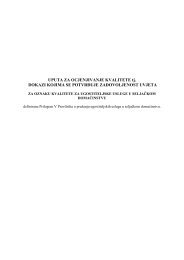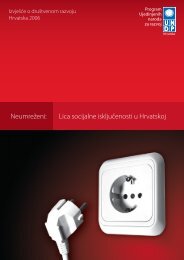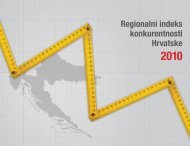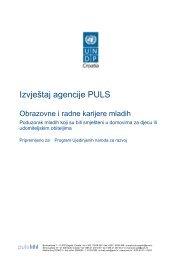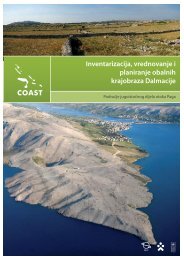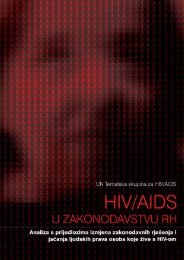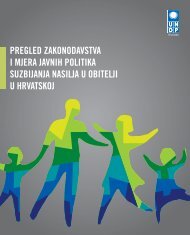WEB engleska verzija end.indd - UNDP Croatia
WEB engleska verzija end.indd - UNDP Croatia
WEB engleska verzija end.indd - UNDP Croatia
- No tags were found...
Create successful ePaper yourself
Turn your PDF publications into a flip-book with our unique Google optimized e-Paper software.
SOCIO-ECONOMIC CONTEXT CHAPTER 2one generation to the next, as the children of disadvantagedparents frequently have restricted access toquality education and healthcare, thereby decreasingtheir employability and reinforcing the cycle (WorldBank, 2006). According to the Human DevelopmentIndex (<strong>UNDP</strong>, 2005), which better describes the qualityof life, since it includes life expectancy and education,in 2004 <strong>Croatia</strong> ranked 44th among 57 countrieswith a high level of human development. <strong>Croatia</strong>displayed a considerable increase in the measure ofhuman development, from 0.799 in 1995 to 0.826 in2000 and 0.846 in 2004.Education, enhancement of knowledge andexpertiseEducation is by far the most important factor in employability.In <strong>Croatia</strong>, as in other countries, peoplewho have better education find jobs more easily, andenjoy other benefits (e.g., easier access to information,better care for one’s health and more activeparticipation in social life - thus encouraging citizens’responsible democratic behaviour - the choice ofdemocracy and the realisation of the rule of law). Theeconomically disadvantaged are especially proneto non-participation in education; they experiencea much higher drop-out rate, which limits their employmentopportunities and increases their exclusion(World Bank, 2001). There are a significant numberof young people in <strong>Croatia</strong> who do not completesecondary school, and even more who never pursuepost-secondary education. To aggravate this situation,there is also a dangerous lack of second chanceschools 24 aimed at young people who have droppedout but may wish to return.Discouraging young people from leaving the educationsystem will require developing an optimumlevel of flexibility and mobility within the system. Thesystem must be adaptable to the needs of participants,society and the market. Flexibility in educationcan be achieved by re-certifying the existing levelsof training and recognising the value of informaleducation. To increase mobility, “blind alleys” must beminimized. Blind alleys are educational paths (typesof programmes) that make it impossible to move tohigher levels of education or to another type of programme.Blind alleys diminish the availability of educationand the utility of human resources. Mobility isachieved by creating a sufficient number of verticaland horizontal paths within the system that enablestudents to customize their education, and avoidthe averaging of students’ achievements. It is theseconnections that offer the possibility of transferringto and between different levels of education.Measures that encourage the return of young peopleto education, especially to secondary and post-secondaryeducation, will increase their employability,reduce unemployment, and mitigate the phenomenaof long-term unemployment and social exclusion.Participation in education has increased in the past25 years across the EU and other developed Europeanstates, however this increase has developed unevenlybetween countries, between national regions, andbetween varying social, economic, and ethnic groups.Although the condition and causes of unemploymentin <strong>Croatia</strong> may differ from the EU, it is estimatedthat <strong>Croatia</strong> (like France and Finland) would benefitfrom motivating unemployed youth to improve theireducation, and (like Spain and Italy) by increasing vocationaleducation and training programmes, (OECD,1996). Substantial efforts need to be made to improvethe basic knowledge of the long-term unemployed,and to develop a new educational approach thatprovides opportunities to gain work experience.Education has become a socially acceptable way ofestimating the value of an individual. It is believedthat those with better education are more intelligent,and more dedicated. The highest level of educationattained is directly related to an individual’s previoussuccess in school, and it is taken as an indicationof the person’s level of motivation, persistence24 Mostly secondary education for adults, which is att<strong>end</strong>ed and completed in <strong>Croatia</strong> by approximately 2,000 persons a year. Of thatnumber, two-thirds are younger than 24.33



